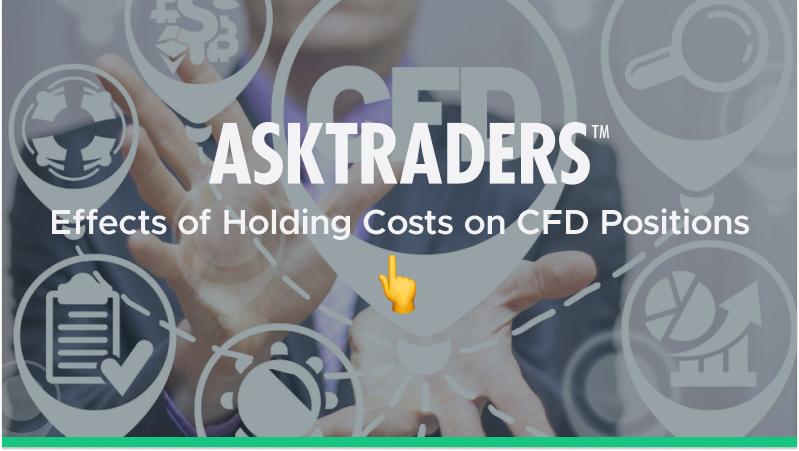When trading CFDs, it is important to consider the impact that broker fees will have on your potential returns. Time isn't just money in CFD trading, it's also a source of hidden expenses.
YOUR CAPITAL IS AT RISK

This article takes you through holding costs and their impact on CFD trading.
Table of contents
What is CFD Holding Costs?
Each trading day closes with the end of the New York trading session. If you still have positions open in your account, most Forex and CFD brokers charge what is known as a holding fee.
The direction of your trades – if you are buying or selling – at the end of the trading day will determine whether these costs are positive or negative based on set calculations for each broker. These calculations include variables such as the number of units held, the opening trade price, the holding rate, and the broker’s currency conversion rate. The resulting amount will then either be credited to your account or debited from it. An example of these CFD holding cost calculations is provided by CMC Markets and will be discussed below.
- Shares
- Indices
- Forex
- Cryptocurrencies
- Commodities and Treasuries
| Markets | CFD Holding Costs |
|---|---|
| Shares | 2.5% on buy and sell positions |
| Indices | Interbank rate of 2.5% |
| Forex | Buy Position Holding Rate = tom-next rate % + 1% Sell Position Holding Rate = tom-next rate % – 1% |
| Cryptocurrencies | Long Position Costs = Number of contracts * value per contract * price * (Broker fee + overnight funding rate) Short Position Costs = Number of contracts * value per contract * price * (Broker fee – overnight funding rate) |
| Commodities and Treasuries | Annualised Price Difference = Price difference / days to contract expiration * 365 Percentage Mid-rate = Annualised price difference / cash price Bid or long Position cost = (percentage mid-rate + (maximum of (absolute of the percentage mid-rate * the haircut) or 0.25%)) * –1 Ask or Short Position cost = (percentage mid-rate – (maximum of (absolute of the percentage mid-rate * the haircut) or 0.25%)) * –1 * The haircut used to generate the price for cash commodities and treasuries is the mid rate +/- 2.5% |
Shares
When trading CFDs in stocks, the interbank rate of the share’s corresponding currency will form the basis of this holding rate. The standard rate for stocks will be 2.5% debited on buy positions and 2.5% credited on sell positions.
However, these fees may vary depending on factors like an underlying bank rate of less than the general 2.5% or if the share has a high borrowing cost on the market. In these cases, holding costs may be charged on selling positions, and borrowing fees may increase.
Indices
The holding rates for index CFDs are similar to that of share CFDs, with the standard underlying interbank rate of 2.5%. It is vital to note that each currency is affected by its own interbank rates and can vary as a result.
For example, AUD follows an interbank rate of a one-month bankers’ acceptance bill, USD has a one-month Libor interbank rate, and ZAR has a one-month deposit interbank rate.
Forex
When it comes to Forex CFD trading, a different calculation applies for holding rates. A variable called tom-next (tomorrow to the next day) holds its own rate for currency pairs, reflected as an annual percentage. For FX CFDs, a buying position will produce a negative holding rate, while a selling rate will produce a positive rate.
The difference between the two affected currencies’ interest rates is used to determine this tom-next rate. If the difference is positive in a buy position, your account will be credited; if the difference is positive in a sell position, your account will be charged accordingly.
Cryptocurrencies
Cryptocurrencies incur credit holding costs for sell positions and debit holding costs for buy positions. Cryptocurrencies have a set holding rate for both the buy and sell positions, and this differs between each crypto.
These rates are set as both overnight and annual costs. When calculating the holding cost, the overnight rate is used, along with the cryptocurrency price and the number of units, to determine how much either will be credited or debited.
Commodities and Treasuries
Underlying futures contracts have holding costs that determine not only the price of cash commodity and treasury products, but also the holding rates for these CFDs. A cash price does not have a fixed expiration date and therefore removes the holding price to create what is known as a continuous cash price.
The above-mentioned deduced cost is then applied to this continuous price afterward. The calculations for this holding cost involve finding the number of days until the expiration date, finding the difference between the current mid-price and the next contract’s mid-price, and then dividing the price difference by the number of days and multiplying the answer by 365.
This will reveal an annualized price term difference. Divide this figure by the cash price to find the percentage mid-rate. Finally, this percentage mid-rate will be used in calculations to determine the holding price on either a buying or selling position.
How Long Can You Hold a CFD?
CFDs do not expire. However, long CFD positions will be expensive after 4-6 weeks as they levy financing charges. Therefore, CFDs are best for short-term trading and speculation of the market, not long-term trading.










